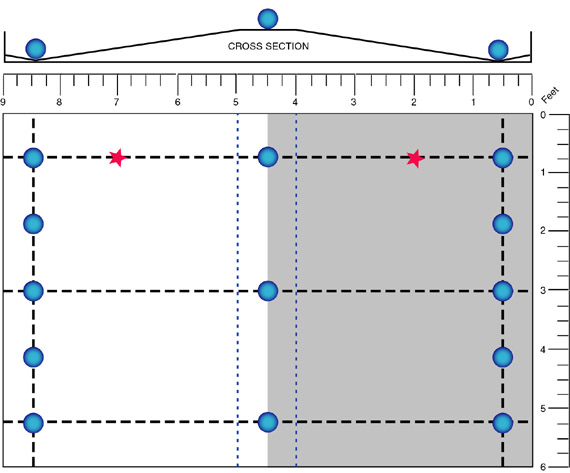The Year 2001 Game: Less is More
Due to a wrinkle in the space-time fabric, your team has been transported back to 1991. You must design an autonomous robot to play in the very first LEGO robot game: RoboPong, designed at MIT. The game is deceptively simple; there are 13 balls on the table, and your job is to keep them on your opponent's side of the table. At the end of the 60 second game, the robot with the fewest balls on its side wins. Good strategy, tracking your opponent, ball handling, and especially reliability will be important.
The board and specific game rules are described below. See the web page of the current game for a description of the contest format, the general contest rules, and the robot construction rules, which do not change signifcantly from year to year.

The game board is 6 feet by 9 feet, but is not flat. As shown in the cross section above, there is a flat, level, 1 foot wide plateau across the center of the board (indicated by the dotted blue lines on the top view), and from there, the surface slopes down on each side to a point about 7.5 inches from the ends. There is also a slope from the ends of the table to the same point, forming a trough about 7.5 inches from each end wall. Balls placed anywhere on the sloping surfaces will tend to roll down and ultimately collect in a trough. The blue circles above show the placement of balls at the beginning of the game. The red stars represent starting lights embedded in the board; a robot starts at each location. One half of the board is painted flat black and has white lines to aid navigation; the other half is painted flat white and has black lines. The lines, indicated in the drawing by dark dashed lines, are 3/4 inch wide. The board has 5 inch high walls at all four sides; the inner side of all the walls are painted flat white.
The slopes in the cross section view (and the size of the balls) have been exaggerated for clarity. The slopes are actually about 2.5 degrees from horizontal, and the total drop from the plateau to the trough is about 1.75 inch. Otherwise, the drawing is reasonably to scale, but the official dimensions are those of the physical game board. Since the board is constructed in parts, there may be small surface and wall misalignments; these should be less than 1/8 inch.
- The balls are standard racquet balls. They are about 2.25 inches in diameter, weigh 1.5 oz, and have a smooth rubber surface. They are resilient and bounce well. The balls may be of various colors but the colors have no significance. All balls are inert and have identical mechanical properties.
- Thirteen balls will be placed on the table at the beginning of the game as shown in the diagram above. Slight indentations or other means may be used to hold the balls in position initially.
- The balls may not be altered, punctured, or destroyed in any way.
Period of Play
- The contestants will have 30 seconds to place their machines on the game board from the time the judges call them. During this time the start lights will be ON to aid in robot alignment. When both teams are ready, and/or the preparation time time is over, the start lights will be turned off and the teams will have a few seconds to prepare their robot to start the game. The robots may be placed in any orientation within the starting area, which is a circle 18 inches in diameter centered on the start light.
- The game will be started by the judges turning on the starting lights, located in the surface of the table in the center of each robot's starting circle, for the first two seconds of the game.
- False Start Rule: A robot that fails to start as expected will be awarded a loss, and may be removed from the table at the judge's discretion. The remaining robot will be allowed to play without opposition.
- The powered portion of a game will last 60 seconds. Software will be provided to cut off power at the end of 60 seconds, and any machine that continues to supply battery power after 60 seconds will lose the game.
- The game ends when both robots and all game pieces come to rest.
- The judges will propose to terminate a game early if neither robot appears to be making any progress. Top
- At the end of the game, the robot with the fewest balls on its side of the table wins.
- Balls on the flat, center plateau of the table do not count for either robot.
- A ball which leaves the table over an end wall, or over a side wall up to the point of the start light (24 inches from the end) will be considered to exist on that side of the board for the rest of the game. The ball will not be returned to the board, but it will be counted in the score.
- Balls which leave the table at some other point will be returned to the board as quickly as possible, and placed on the center plateau. The order of preference for ball replacement is: the center position, the side position by the start lights, the other side position, or any unobstructed location on the table center. Top
